

It will come as a surprise to some, but even Meghan has a right to her privacy. Do you remember that tabloid staple, the shagging footballer?

The love rat who played away, scoring with a casually met blonde who duly capitalised on her encounter with a spot of what used to be fondly known as kiss’n’tell? We don’t read so much about such beasts these days. I’m guessing this is not because young footballers have become more chaste or God-fearing. It’s because newspapers have become unable to persuade judges that it is in the public interest for the striker’s marital misdemeanours to be splattered all over their front page. Blame it on the Europeans – and the tabloids did. I parody only slightly. Thus we were landed with what editors were encouraged to disparage as “judge-made privacy law” or a “privacy law by the back door”. But will it? Footballers, celebrities and royals clearly have a very public aspect to their lives. Documents. Documents.
Case-law guides. MAX MOLSEY V GOOGLE. Naomi Campbell. Balance privacy/freedom of expression. Mosley attack Google.
Le respect de la vie privée face à la liberté d’expression et au droit à l'information. Le droit met en balance des principes juridiques antagonistes : - la liberté d’expression et le droit à l'information ; - le droit au respect de la vie privée de chacun.
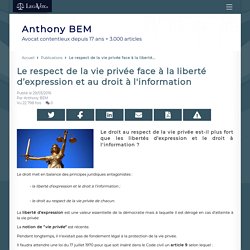
La liberté d’expression est une valeur essentielle de la démocratie mais à laquelle il est dérogé en cas d'atteinte à la vie privée La notion de "vie privée" est récente. Pendant longtemps, il n'existait pas de fondement légal à la protection de la vie privée. Il faudra attendre une loi du 17 juillet 1970 pour que soit inséré dans le Code civil un article 9 selon lequel : "chacun a droit au respect de sa vie privée". L’article 9 du Code civil qui comporte des termes très généraux a surtout permis aux juges de forger une jurisprudence protectrice du droit au respect de la vie privée des personnes. Ainsi, toute personne, même celle qui exerce des activités publiques, politiques, économiques ou professionnelles peut se prévaloir du principe du droit au respect de la vie privée. Convention de sauvegarde des Droits de l'Homme et des Libertés fondamentales (int) Un article de JurisPedia, le droit partagé.

Droit à la vie privée dans la jurisprudence sur la liberté d'expression de la Cour européenne des droits de l'homme (int) Un article de JurisPedia, le droit partagé. « Nous n'avons qu'une liberté : la liberté de nous battre pour conquérir la liberté… [1] » Le droit au respect de la vie privée et la liberté d'expression sont tout deux reconnus comme étant essentiels dans une société démocratique.
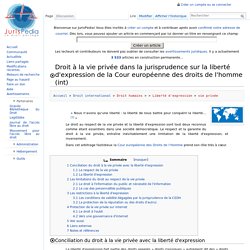
Le respect et la garantie du droit à la vie privée, entraîne inévitablement une limitation de la liberté d'expression, et inversement. La liberté d'expression fait partie des droits appelés « droits classiques » autrement dit des « droits de première génération ». La constitutionnalisation du droit au respect de la vie privée. (1) N.

Molfessis, Le Conseil constitutionnel et le droit privé, préf. Strasbourg Case Law: Defamation and Balancing Articles 8 and 10 – Inforrm's Blog. The Court of Human Rights has considered the balance between Articles 8 and 10 of the Convention in a number of defamation cases over the past year.
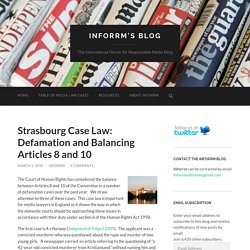
We draw attention to three of these cases. This case law is important for media lawyers in England as it shows the way in which the domestic courts should be approaching these issues in accordance with their duty under section 6 of the Human Rights Act 1998. The first case is A v Norway (Judgment of 9 April 2009). The applicant was a convicted murderer who was questioned about the rape and murder of two young girls. A newspaper carried an article referring to the questioning of “a 42-year-old convicted murderer from Kristiansand” without naming him and including a photograph of the applicant, although not showing his face. Freedom of Expression and Right To Privacy.
Reynolds v Times Newspapersu. All Answers Ltd.
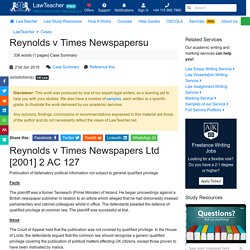
(November 2018). Reynolds v Times Newspapersu. Retrieved from Reference Copied to Clipboard. England and Wales Court of Appeal (Civil Division) General Introduction 1.
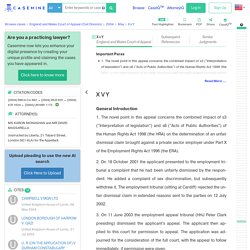
The novel point in this appeal concerns the combined impact of s3 ("Interpretation of legislation") and s6 ("Acts of Public Authorities") of the Human Rights Act 1998 (the HRA) on the determination of an unfair dismissal claim brought against a private sector employer under Part X of the Employment Rights Act 1996 (the ERA). 2. On 18 October 2001 the applicant presented to the employment tribunal a complaint that he had been unfairly dismissed by the respondent.
He added a complaint of sex discrimination, but subsequently withdrew it. Wainwright v United Kingdom - 5RB Barristers. Reference: Application No. 12350/04 Court: European Court of Human Rights Judge: Casadevall (President), Bratza, Pellonpaa, Maruste, Traja, Mijovic, Sikuta (Judges) and Early (Section Registrar) Date of judgment: 26 Sep 2006 Summary: Human Rights - Prohibition of inhuman and degrading treatment - Article 3 - Respect for private and family life - Article 8 - Effective domestic remedy - Article 13 - Prison visit - Strip search Download: Download this judgment.
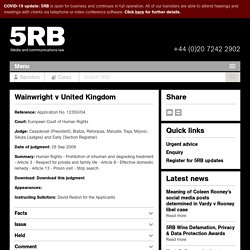
Wainwright v Home Office - 5RB Barristers. Reference: [2003] UKHL 53; [2004] 2 AC 406; [2003] 3 WLR 1137; [2003] 3 All ER 943 Court: House of Lords Judge: Lords Bingham, Hoffmann, Hope, Hutton & Scott Date of judgment: 16 Oct 2003 Summary: Tort – Intentional infliction of harm – Visitors to prison strip-searched for drugs – Distress and humiliation inflicted – Privacy – Article 8 European Convention on Human Rights - Whether English common law recognises a cause of action for invasion or privacy- Remedies Download: Download this judgment.

Von Hannover v. Germany (No. 2) Case Summary and Outcome The European Court of Human Rights (“ECtHR”) found that two photographs depicting a royal family on holiday and published in two German newspapers violated the right to privacy pursuant to Article 8 of the European Convention on Human Rights (“ECHR”) because they did not reflect any matter of public interest detailed in the accompanying text. However, a third photograph depicted a Prince in poor health, and since the health of the Prince was a matter of public concern the ECtHR found no violation of Article 8.
In reaching its ruling the ECtHR set out the criteria which domestic courts should follow when balancing the right to privacy pursuant to Article 8 against the right to freedom of expression under Article 10. Facts. ROBERSON v. ROCHESTER FOLDING BOX CO. PARKER, Ch. England and Wales High Court (Chancery Division) Crown Copyright © 1. MR JUSTICE BELL: This is an application on behalf of the claimant, Ms Elizabeth Jagger, for an order that John Darling and other defendants who are identified as "person or persons who acquired or made a copy of the CCTV recording of the said incident and supplied it or images taken from it to the News of the World newspaper" must not until the trial or further order of the court disclose, publish, republish, syndicate, use, communicate or disclose to any party any CCTV film footage or other movie or still image, whether original or copied, featuring, showing, picturing or identifying in any way by way of image or sound or otherwise the claimant at Kabaret nightclub on 16 and/or 17 February 2005 and any part, section or extract thereof.
Prince Albert v Strange: ChD 8 Feb 1849 - swarb.co.uk. Albert_strange1849 References: (1849) 1 H and Tw 1, 2 De G and SM 293, (1849) 1 Mac and G 25, [1849] EWHC Ch J20, [1849] EngR 255, (1849) 41 ER 1171, [1849] EngR 261, (1849) 47 ER 1302, (1849) 2 De Gex and Sim 652 Links: Bailii, Commonlii, Commonlii Coram: Vice-Chancellor Knight-Bruce, Lord Cottenham LC Ratio: The Prince sought to restrain publication of otherwise unpublished private etchings and lists of works by Queen Victoria.
The etchings appeared to have been removed surreptitiously from or by one Brown. A personal confidence was claimed. Held: The jurisdiction in confidence is based not so much on property or on contract as on a duty of good faith. (This list may be incomplete) This case is cited by: Cited – Douglas etc v Hello! England and Wales Court of Appeal (Civil Division) The basic facts 1 Hello! Ltd ("Hello! ") House of Lords - OBG Limited and others (Appellants) v. Allan and others (Respondents)Douglas and another and others (Appellants) v. Hello! Limited and others (Respondents)Mainstream Properties Limited (Appellants) v. Young and others and another (Respond.
OBG Limited and others (Appellants) v. Allan and others (Respondents) Douglas and another and others (Appellants) v. Hello! Limited and others (Respondents) Mainstream Properties Limited (Appellants) v. My Lords, The IT Law Wiki. Citation[edit | edit source] Melvin v. Reid, 112 Cal.App. 285, 297 P. 91 (1931). Factual Background[edit | edit source] Appellant Melvin was at one time a prostitute who was tried for murder and later acquitted. According to the Appellant she abandoned her former life in 1918, rehabilitated herself, and married her husband a year later. Hosking and Hosking v. Runting and Pacific Magazines NZ Ltd. Download this summary here Title: Hosking and Hosking v. Runting and Pacific Magazines NZ Ltd Court: New Zealand Court of Appeal Date: March 25, 2004. Francome v Mirror Group Newspapers Ltd: CA 1984 - swarb.co.uk. Douglas v Hello! Ltd - 5RB Barristers. Reference: [2001] QB 967; [2001] 2 WLR 992; [2001] 2 All ER 289; [2001] EMLR 199; [2001] FSR 732. De May v. Roberts.
Coco v. a.n. Clark (Engineers) Ltd [1969] Rpc 41. Reports of Patent, Design and Trade Mark Cases. Campbell v MGN Ltd (CA) - 5RB Barristers. Reference: [2002] EWCA Civ 1373; [2003] QB 658; [2003] 2 WLR 80; [2003] EMLR 39 Court: Court of Appeal Judge: Phillips MR, Chadwick & Keene LJJ. Australian Broadcasting Corporation v Lenah Game Meats. Privacy Before the Human Rights Act 1998 Cases.
Duchess of Argyll v Duke of Argyll: ChD 1967 - swarb.co.uk. A v B [2002] 2 All ER 545. NEW Caselaw 06 2020 clean. Fs data eng. Arrêté du 7 avril 2011 relatif au respect de l'anonymat de certains fonctionn...